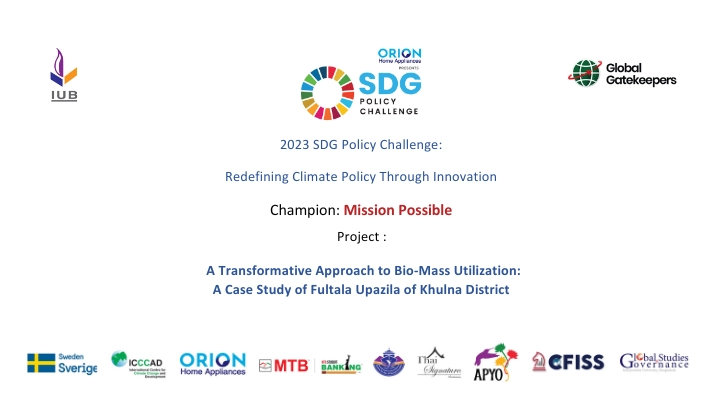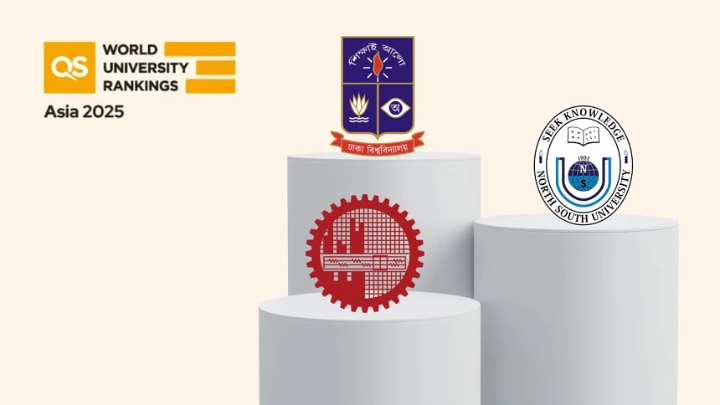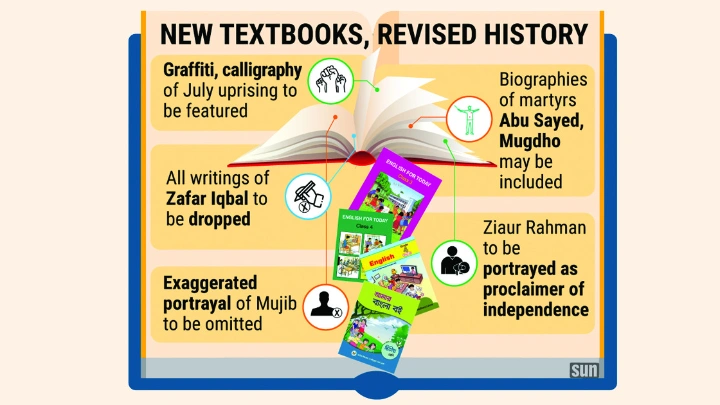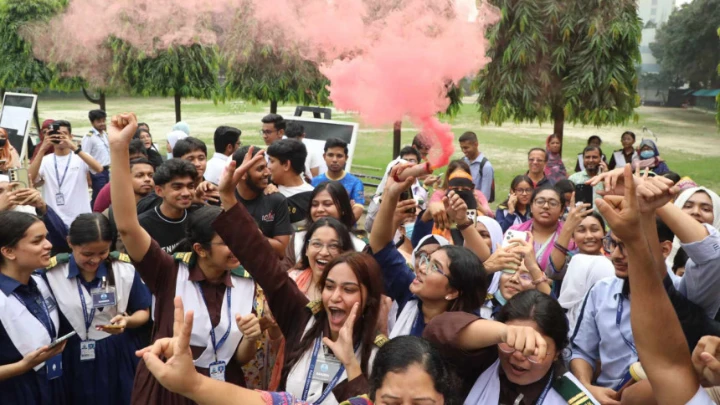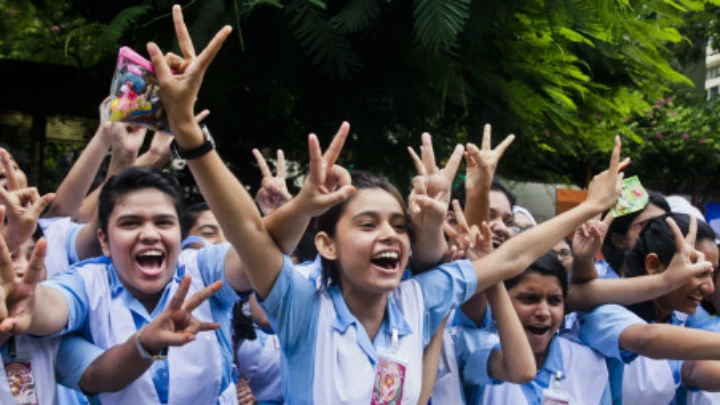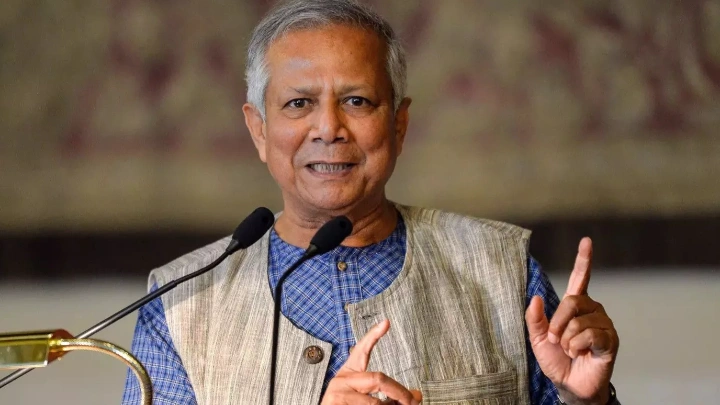A Transformative Approach to Biomass Utilization: A Case Study of Phultala Upazila of Khulna District
Khadiza Tasnim, Mubashwara Mehzabeen, Tasfiah Akter Tanjel, Yazdi Zaman - IUB || Shining BD
Introduction:
The International Energy Agency's 2022 report estimates that 2.3 billion people globally cook with biomass on a daily basis (IEA, 2023). As per the report of the Bangladesh Bureau of Statistics (BBS), approximately 92% of rural households in Bangladesh (Rahman, 2023) specifically in the Khulna district (97%) utilize a diverse range of biomass fuels for cooking every day (Biswas et al., 2023). The policy brief addresses the significance of sustainably utilizing biomass in cooking stoves by replacing Traditional Cooking Stoves (TCS) with Smart ICS (Improved Cooking Stoves). Our target beneficiaries are individuals who rely on biomass for everyday cooking and aim to promote sustainable utilization of biomass within their existing cooking routines in Phultala Upazila, Khulna. Indoor air pollution and health hazards arising from using TCS which runs on biomass cause an estimated welfare loss of $1.5 trillion each year (World Bank, 2019).
According to the Sustainable and Renewable Energy Development Authority (SREDA), ICS reduces firewood consumption by up to 50 percent (Roy & Hasan, 2022). To improve energy efficiency, reduce firewood consumption, and cut down on greenhouse gas emissions about 45 lakh ICS have been installed in households across the country (ibid). As such, Smart ICS will play a conducive role in further reducing toxic gas emissions and help to protect the environment as well.
Design and Implementation:
Researchers propose the metallic ICS as the ideal type, emphasizing the distinctive features of metallic ICS through innovative combustion technology (Okino et al., 2021;Ahmad et al., 2022). This design not only efficiently retains heat but also directs a significant portion towards the cooking pot, with insulation minimizing heat wastage between the inner chamber and outer body.
Regarding the design of the Smart ICS, it surpasses current ICS models in Bangladesh across various parameters, including fuel reduction, cooking time, lifespan, efficiency, and maintenance.
The existing ICS in Bangladesh is a fixed-type stove designed for both domestic and institutional use. Priced at 800-1200 Tk for domestic settings and 3000-5000 Tk for institutional purposes, it offers a fuel use reduction of 40-50%. While requiring regular maintenance, its estimated lifespan ranges from 3-5 years. This stove, with moderate smoke emission, contributes to a 50% reduction in Carbon Dioxide (CO2) emissions nationally. However, specific data on Carbon monoxide (CO) reduction and particulate matter reduction for wood fuel are not available.
In contrast, the Smart Stove this policy suggests is a portable solution priced between 2000-4000 Tk. Remarkably, it achieves a higher fuel use reduction coupled with a cooking time reduction of up to 50%. This stove boasts a longer estimated lifespan, and requires no regular maintenance. With less smoke emission, it contributes to a significant reduction in CO2 emissions and an impressive reduction in CO emissions. Additionally, it reduces particulate matter when using wood fuel. This Smart Stove offers a practical and efficient alternative for users seeking portability and reduced environmental impact. Smart ICS offers a practical and efficient alternative for users seeking portability and reduced environmental impact. Interestingly, the greatest demand is for single burner stoves with two fuel chambers (Islam, Roy & Rahman, 2022) and the Smart ICS is also a single burner stove.
When the emissions from a single mouth cook stove with or without a chimney were compared to those from a traditional cook stove, it was discovered that the TCS produced higher levels of PM10, PM2.5, including BC and CO. Therefore, it can be said that a Smart ICS burns fuel better than the existing ICS.
It is pertinent to note that the statistical information pertaining to the Smart ICS has been sourced from Envirofit's official data on metallic cooking stoves to build an understanding of the possible outcomes of using Smart ICS in Bangladesh. Additionally, data for ICS units in Bangladesh has been derived from reputable organizations engaged in clean cooking stove initiatives within the country, including the Bondhu Foundation, Sustainable and Renewable Energy Development Authority, Household Energy Platform, among others.
The uniqueness of the Smart ICS that this policy brings forward lies in the incorporation of temperature and weight measurement technology, enabling precise fuel consumption calculations. A digital display, powered by a battery, will showcase this information. To ensure judicious fuel use, a policy will subsidize the final installment payment upon confirmation by the monitoring team, relying on the pre-installed device's AI chip. The chip maintains a consumption record. While users cover the initial three installments, we strive to enhance awareness and offer training for sustainable biomass use with the Smart ICS. Our primary research shows that there is no drainage system in Phultala Upazila, so cities and villages get waterlogged, and people are bound to cook inside their homes during the rainy season. A little rain floods the entire region. Sometimes, they place their stoves on the bed and cook. Under the circumstances, a Smart stove will play a conducive role since it is portable and provides clean cooking.
In our future endeavors, we plan to endorse Smart ICS usage under the UNFCCC's Clean Development Mechanism (CDM) carbon credit plan, facilitated by the IFC. By trading carbon credits globally, we aim to generate a revenue stream that supports the project and community development initiatives.
Impacts:
General Impacts
1.SDG 1:
Transitioning from TCS to Smart ICS can reduce fuel consumption, save money, and alleviate poverty in Bangladesh (Climate Impact Partners, n.d.; myclimate, n.d.).
2. SDG 3:
According to the World Health Organization (WHO), 113,202 Bangladeshis die annually from indoor air pollution from TCS, and transitioning to Smart ICS could significantly reduce health concerns and mortality rates (Climate Impact Partners, n.d.; myclimate, n.d.; VNV Advisory, 2023).
3. SDG 7, SDG 11, and SDG 13:
Biomass cooking stoves provide clean, affordable energy, reducing toxic emissions by up to 82% (SDG 7) (Climate Impact Partners, n.d.; myclimate, n.d.; VNV Advisory, 2023). This promotes clean indoor and outdoor air, promoting sustainable cities and communities (SDG 11). Biomass cooking stoves reduce greenhouse gas and black carbon emissions. This contributes to climate action by minimizing the impact of climate change (SDG 13) (Climate Impact Partners, n.d.; myclimate, n.d.; VNV Advisory, 2023).
4. SDG 15:
Shifting to cleaner biomass stoves can help conserve forests and reduce the pressure on natural resources. This protects and promotes sustainable use of terrestrial ecosystems, reducing biodiversity loss, which aligns with SDG 15 (Climate Impact Partners, n.d.; myclimate, n.d.; VNV Advisory, 2023).
5. SDG 17:
Governments, NGOs, international organizations, and local communities can collaborate to achieve the SDGs by promoting ICS, and sustainably using biomass.
Environmental Impacts
Traditional biomass stoves play a role in causing deforestation and harming the environment. Transitioning to more environmentally friendly ICS can aid in the preservation of forests and alleviate the strain on natural resources (VNV Advisory, 2023). Smart ICS can reduce biomass fuel consumption by around 30-37% compared to TCS, bringing about positive environmental benefits. It will reduce fuel use by 66%, reduce CO2 emission by 66%, reduce CO emission by 82%, and reduce particulate matter by 70%. Smart ICS would reduce long term particulate matter (PM2.5) exposures from around 200-300 µg/m3 to 75-150 µg/m3 (Larsen, 2016). The use of Smart ICS helps reduce indoor air pollution.
Social Impacts
1. Health Advantages
Chronic obstructive pulmonary disease in adults, lung cancer, ischemic heart disease, cerebrovascular illness, and acute lower respiratory infections in children under five are the main health effects of long-term exposure to PM2.5 in the home environment (Larsen, 2016). Smart ICS can mitigate respiratory problems, childhood pneumonia, and long-term health risks linked to indoor air pollution, notably benefiting women and children. Thus, the transition to Smart ICS notably reduces mortality rates, addressing a major public health hazard. It can yield more than 19-24% reduction in health effects if all households in the community adopt ICS (VNV Advisory, 2023).
2. Empowering Women
ICS simplifies cooking, providing women with more time which could be utilized for other activities, such as education and income generation. Engaging women to distribute these stoves promotes economic empowerment and poverty reduction in rural households (VNV Advisory, 2023).
3. Reduced Fuel Consumption
ICS lessens the financial burden on families by decreasing biomass fuel consumption, thus conserving natural resources and reducing the need for large fuel purchases (VNV Advisory, 2023).
4. Time Efficiency
ICS reduces cooking time, benefiting women who can use the saved time for education, income generation, and family (Ahmad et al., 2022).
Adaptation and Mitigation:
Smart ICS plays an instrumental role in climate change mitigation efforts by conserving energy, leading to fuel savings and a reduction in CO2 emission. The Smart ICS aligns with the Bangladesh Delta Plan 2100 as it reduces greenhouse gas emission. It also helps to develop climate-smart cities with effective use of non depletable energy mechanisms, which is a vision of the “National Adaptation Plan” (NAP) of Bangladesh (2023-2050).
Adaptation measures include training and awareness, financial incentive, temperature and weight device, and portability.
Mitigation measures include coordinating with national and global climate change goals and SDG, environmental benefits like reduced deforestation, GHG emission and biodiversity loss, health benefits like reduced risks of respiratory and long-term diseases, and reduced fuel consumption.
Climate Change Adaptation:
Smart ICS is an excellent climate change adaptation strategy. To highlight, Smart ICS is portable which can be considered as an adaptive method to counter challenges faced by rain induced flooding in Phultala Upazila with no drainage system to wash out rain water. People can cook anywhere during a crisis. Thus, ensuring food security as well.
Cost-Benefit Analysis:
A comprehensive cost-benefit analysis from the perspective of consumers and the environment illustrates that the benefits exceed the cost by more than 2.7 times approximately, which provides a strong rationale for the implementation of the policy project.
The costs in question include cost of implementation of policy including awareness, promotion, training, and incentives and costs borne by consumers including installment payments and fuel use. The costs were estimated based on thorough market research and expert opinion.
The benefits include environmental benefit from quantity savings in fuelwood use through lower consumption of fuelwood to operate ICS, consumer monetary savings through cost reduction due to reduced fuelwood requirements, time savings due to reduction in cooking time, and consumer health benefit associated with reduced indoor air pollutants emission.
Quantifiable benefits were estimated based on primary data collection. Attempts to quantify time and health were carried out based on the economic concepts of valuation of time at 50% of the female hourly rural wage rate and Value of Statistical Life (VSL) respectively.
Financing Strategy:
The financing strategic mix involves national resources like the Bangladesh Climate Change Trust Fund (BCCTF), international partners such as Global Environmental Facility (GEF) and contributions from the domestic private sector.
BCCTF is the first-ever national climate fund established by an LDC country. The funding comes from the national budget itself and allocation of Tk.300 crore for Khulna region for the FY 2023-24 has been made according to the Ministry of Finance Climate Funding Report 2023-24.
GEF is a potential fund towards reaching RE goal of 2041 as expressed by a renewable energy research organization of Bangladesh named Change Initiative. GEF has co-funded over 60 projects in Bangladesh related to climate change. They currently have allocated unutilized funds of around USD 4.58 million for projects in Bangladesh that can be accessed through the operational focal point in the country.
As for contributions from the private sector, we are targeting receiving funds through what is known as Corporate Social Responsibility that obligates larger organizations to put aside funds towards the environment and is mandatory for commercial banks as well. Our targets are Akij, Rahmiafrooz, Bangla Cat, and Prime Asia Bank.
Policy Implications:
The policy brief complies with the “National Action Plan for Clean Cooking” (2020-2030) as set forth by the Government of Bangladesh in 2019. Smart ICS aligns with the “National Adaptation Plan of Bangladesh” (2023-2050), aiming for 40% household use of ICS by 2030, compared to only 3% to 5% currently in use (Aziz et al., 2022).
In addition to that, the policy aligns with the “Bangladesh Biodiversity Act 2017”, passed in line with Bangladesh’s constitutional mandate under Article 18A (Act No. of 1972) and international mandates under the “Convention on Biodiversity” which aligns with SDG15 as well (Lubaba, 2019).
It is worth mentioning that in 2019, the Bangladesh Parliament became the first legislature in the world to declare a planetary emergency, emphasizing on biodiversity and urging the global community to achieve net zero emissions by 2050 (Huq, 2020).
To highlight, the Mujib Climate Prosperity Plan (Climate Resilience Strategy) aims to promote wellbeing by using 21st century technology to make traditional lifestyle practices sustainable which Smart ICS aligns with as well. Hence, Smart ICS fits into the picture just perfectly with its ideal characteristics of reducing fuel consumption and hence protecting the environment.
Key Findings:
- Globally, almost 2.3 billion people cook their meals every day using biomass.
- In Bangladesh's rural households (92%) specifically in the Khulna district (97%), biomass fuels are widely used for cooking.
- The policy aims to address sustainable biomass utilization by replacing Traditional Cooking Stoves (TCS) with Smart ICS.
- Traditional Cooking Stoves (TCS) contribute to indoor air pollution and health hazards, causing an estimated welfare loss of $1.5 trillion annually.
- Smart ICS reduces firewood consumption by up to 50%, with approximately 45 lakh ICS installed across the country.
- The metallic Smart ICS design emphasizes innovative combustion technology, efficiently retaining heat and directing it towards the cooking pot.
- The existing ICS in Bangladesh has a fuel use reduction of 40-50% with a lifespan of 3-5 years while the proposed Smart ICS is portable, priced between 2000-4000 Tk, achieving a higher fuel use reduction of 66%, with a longer lifespan of 4-7 years and reduced emissions.
- Smart ICS incorporates temperature and weight measurement technology for precise fuel consumption calculations.
- A digital display powered by a battery showcases information to ensure judicious fuel use.
- The policy subsidizes the final installment payment upon confirmation by the monitoring team.
- The project plans to endorse Smart ICS usage under the UNFCCC's Clean Development Mechanism (CDM) carbon credit plan, generating revenue to support community development initiatives.
- Addresses multiple Sustainable Development Goals (SDGs).
- The transition to Smart ICS can reduce fuel consumption, save money, improve health, and contribute to climate change mitigation.
- Smart ICS reduces biomass fuel consumption by 30-37% compared to TCS.
- Achieves a 66% reduction in CO2 emissions, an 82% reduction in CO emissions, and a 70% reduction in particulate matter when using wood fuel.
- Helps reduce long-term particulate matter exposures, contributing to reduced indoor air pollution.
- Major health benefits include mitigating respiratory problems, childhood pneumonia, and long-term health risks.
- Empowers women by providing more time for education and income-generating activities.
- Reduces financial burden on families through decreased biomass fuel consumption.
- Smart ICS contributes to climate change mitigation by saving fuels and reducing CO2 emissions.
- It aligns with Bangladesh's Delta Plan 2100 and National Adaptation Plan (NAP) by promoting renewable energy mechanisms and climate-smart cities.
- Comprehensive analysis indicates benefits exceed costs by more than 2.7 times, supporting the rationale for policy implementation.
- Benefits include environmental, monetary, time, and health benefits.
- The financing mix involves national resources like the Bangladesh Climate Change Trust Fund (BCCTF), international partners like the Global Environmental Facility (GEF), and contributions from the domestic private sector.
- BCCTF and GEF are potential funding sources, and contributions from the private sector (Akij, Rahimafrooz, Bangla Cat, Prime Asia Bank) will be sought through Corporate Social Responsibility.
Conclusion:
The proposed Smart ICS policy project offers a transformative solution, addressing challenges tied to traditional biomass cooking. It is worth noting that our policy will not be applicable in urban areas, where the most of the population relies on modern cooking methods like LPG or electric stoves. Success of this ICS relies on community engagement, strategic partnerships, and continuous monitoring. The initiative envisions improved health, environmental conservation, and economic empowerment, aligning with Sustainable Development Goals (SDGs). Anticipated improvements include better health outcomes, environmental protection, and socio-economic conditions. This paper represents a collective effort for positive change, demonstrating the potential for impactful change when technology, community engagement, and environmental consciousness converge. Through shared commitment, we aim to pave the way for a cleaner, healthier, and more sustainable world.
References:
Ahmad, R., Ilyas, H. N., Li, B., Sultan, M., Amjad, M., Aleem, M., Abbas, A., Imran, M. A., & Riaz, F. (2022). Current challenges and future prospect of biomass cooking and heating stoves in Asian Countries. Frontiers in Energy Research, 10, 880064.
Aziz, S., Barua, S., & Chowdhury, S. A. (2022). Cooking energy use in Bangladesh: Evidence from technology and fuel choice. Energy, 250. https://doi.org/10.1016/j.energy.2022.123696
Bangladesh. (n.d.). GEF. Retrieved December 28, 2023, from https://www.thegef.org/projects-operations/country-profiles/bangladesh
Biswas, R., Sharmin, A., uzzaman, M. A., & Islam, M. A. (2023, August 28). (PDF) Assessing rural households' biomass consumption patterns in three Upazilas in Khulna district of Bangladesh. ResearchGate. Retrieved December 29, 2023, from https://www.researchgate.net/publication/373143438_Assessing_rural_households'_biomass_consumption_patterns_in_three_Upazilas_in_Khulna_district_of_Bangladesh
C-Quest Capital. (n.d.). Clean Cookstoves. C-Quest Capital. https://cquestcapital.com/projects/clean-cookstoves/
CLIMATE FINANCING FOR SUSTAINABLE DEVELOPMENT. (2023). Ministry of Finance, page 64. Retrieved December 28, 2023, from https://mof.portal.gov.bd/sites/default/files/files/mof.portal.gov.bd/page/6e496a5b_f5c1_447b_bbb4_257a2d8a97a1/Climate%20English.pdf
Climate Impact Partners. (n.d.). ⠀IMPROVED COOKSTOVES, INDIA. Retrieved 2023, from https://www.climateimpact.com/global-projects/improved-cookstoves-india/?fbclid=IwAR3Kvgi9OwlZXee8yZNMsttutrXaVyHfN92HUa5ycKS8N4i9DZ1uoHh2QCU
Huq, S. (2020). Protecting the environment should be everyone's concern. The Daily Star. https://www.thedailystar.net/opinion/politics-climate-change/news/protecting-the-environment-should-be-everyones-concern-1872967
IEA. (2023). A Vision for Clean Cooking Access for All. IEA. Retrieved 2023, from https://www.iea.org/reports/a-vision-for-clean-cooking-access-for-all/executive-summary?fbclid=IwAR07Nhr__ZDH6ElwRvCnvbfrhVQ-pCl9ZOX6dc52iJJO5ObrZiI_WHFEt04
Islam, A., Roy, H., & Rahman, M. M. (2022). Energy efficiency study of household natural gas burner using pot-bottom shield and modified pot arrangement. Energy Reports, 8, 12871-12885
Khan, M Zakir Hossain and Bari, Estiaque and Siddique, Simran Nova and Alam, Samsul, Renewable Energy Finance in Bangladesh – Risk and De-risk Mechanisms (September 1, 2023). Available at SSRN: https://ssrn.com/abstract=4573081 or http://dx.doi.org/10.2139/ssrn.4573081
Larsen, B. (2016). Benefits and Costs of Household Cooking Options for Air Pollution Control. Copenhagen Consensus Center.
Lubaba, T. (2019). An Overview of Environmental Laws of Bangladesh. The Daily Star. https://www.thedailystar.net/law-our-rights/news/overview-environmental-laws-bangladesh-175336
myclimate. (n.d.). ⠀Efficient Cook Stoves reduce Emissions in Bangladesh. Retrieved 2023, from https://www.myclimate.org/en/get-active/climate-protection-projects/detail-climate-protection-projects/bangladesh-efficient-cook-stoves-7241/?fbclid=IwAR1Z_zOiCRVZJHsfZkr_bIlhPxrJcjQ1vuiSfyiSbHnKISlrpTKxuVlEOvM
Okino, J., Komakech, A. J., Wanyama, J., Ssegane, H., Olomo, E., & Omara, T. (2021). Performance Characteristics of a Cooking Stove Improved with Sawdust as an Insulation Material. Journal of Renewable Energy, 2021, 1–12. https://doi.org/10.1155/2021/9969806
Rahman, M. (2023, June). Access to clean energy for cooking in Bangladesh drops to 28% in 2022: BBS. The Business Standard. https://www.tbsnews.net/bangladesh/access-power-clean-energy-bangladesh-drops-28-2022-bbs-648858
Rahman, M. (2023, June). Access to clean energy for cooking in Bangladesh drops to 28% in 2022: BBS. The Business Standard. https://www.tbsnews.net/bangladesh/access-power-clean-energy-bangladesh-drops-28-2022-bbs-648858
Roy, D., & Hasan, M. (2022, February 11). Improved cook stoves: saving lives, cutting fuel cost. The Daily Star. https://www.thedailystar.net/business/economy/news/improved-cook-stoves-saving-lives-cutting-fuel-cost-2959436
VNV Advisory. (2023). Cookstoves: An Eco-Friendly Solution for Sustainable Cooking. VNV Advisory. Retrieved December 29, 2023, from https://vnvadvisory.com/cookstoves-an-eco-friendly-solution-for-sustainable-cooking/
World Bank. (2019). Clean Cooking: Why It Matters [Film]. https://www.youtube.com/watch?v=4FNpx8VvyIE
World Bank. (n.d.). Understanding Market Based Solutions and Access to Finance Options for Clean Cooking Technologies in Bangladesh.
Shining BD

